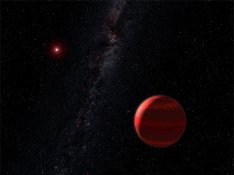Don't Pack Your Bags Just Yet
 You can't swing a dead cat-5 cable on the Interwebs today without running across a link to the "new Earth" discovered around a red dwarf star called Gliese 58, about 20 light years away from Earth (not just in our back yard, but -- relatively speaking -- right behind us, reading over our shoulder, breathing stale dorito breath in our face). Let's guess the order of the blog storm: first, someone will say "it's a habitable planet!"; then, someone will say "we should move there!"; then, someone will say "you just want to trash the Earth and leave it like a cheap rental!"; finally, someone will say "hold on, folks, all they found was a planet that's likely to be "rocky" (instead of gaseous like Jupiter) in an orbit that would allow water to remain water. That's it. No signs of water, no actual proof of habitability, certainly no signs of life. Calm down."
You can't swing a dead cat-5 cable on the Interwebs today without running across a link to the "new Earth" discovered around a red dwarf star called Gliese 58, about 20 light years away from Earth (not just in our back yard, but -- relatively speaking -- right behind us, reading over our shoulder, breathing stale dorito breath in our face). Let's guess the order of the blog storm: first, someone will say "it's a habitable planet!"; then, someone will say "we should move there!"; then, someone will say "you just want to trash the Earth and leave it like a cheap rental!"; finally, someone will say "hold on, folks, all they found was a planet that's likely to be "rocky" (instead of gaseous like Jupiter) in an orbit that would allow water to remain water. That's it. No signs of water, no actual proof of habitability, certainly no signs of life. Calm down."
So, jumping to the conclusion: calm down.
This is cool news, to be sure, but really only from the perspective that it supports the argument that the preconditions for Life As We Know It -- i.e., water and a stable orbit around a reasonably long-lived star -- appear to be, in fact, about as commonplace as had been conjectured.
But don't worry about Earth-haters moving there. By the time we have the technology that would make a 20 light year trip even remotely plausible (the fastest space craft yet made would still take thousands of years to get there), we probably won't be all that interested in living in a watery gravity hole anyway. Nope -- give us some nice, massive gas giants to convert to computronium!






Comments
Yeah, it's pretty funny reading most of the comments about this. Michael Anissimov wrote something interesting about it:
http://www.acceleratingfuture.com/michael/blog/?p=415
Personally, I’m excited about it because it’s an interesting discovery and can help us know more about the universe.
I’m particularly fascinated with the instruments they used to make the discovery.
Posted by: Michael Graham Richard | April 25, 2007 8:42 PM
I read that this Gliese planet has a surface gravity (at least) twice that of Earth...
If intelligent beings lived on that "heavy" planet, what would their spacecraft look like (if they had any)?
Posted by: A.R.Yngve | April 27, 2007 5:11 AM